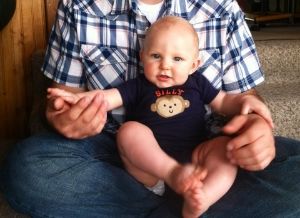The 51/49 Boy/Girl RatioThe ratio of 51% boys to 49% girls seen here is
representative of overall US birth rates. There are many hypotheses about why
there are slightly more boys born each year than girls, but no one knows for
sure why this is so. Here are a couple of the theories:
- Males are more fragile (male infants are less likely to survive their first
year, and a man's expected lifespan is less than a woman's). The slightly higher
conception rate of males is nature's way of evening out the balance.
- As Shettles contents, Y-bearing male-producing sperm
may have a speed advantage over X-bearing female-producing sperm, more often
winning the race to fertilize the egg and resulting in more male conceptions.
Regardless of the reason, the 51/49 ratio remains constant year to
year throughout the US population.
Are Boys or Girls Preferred?The Chance study describes "stopping
behavior" -- the tendency of parents to stop having children after having the
desired gender or genders. Parents in the US may have a "balance preference", a
desire to have one of each gender. Here's what the data shows:
Did the first child's gender influence whether to have a second child?
- Parents are slightly more likely to stop having children if the first
child is a girl.
| First Child |
Parents Having 2nd Child |
|---|
| Boy |
 70%
70% |
|---|
| Girl |
 68%
68% |
|---|
Did previous children's gender influence whether to have a third child?
- Parents are 6% more likely to stop having children if the first two children
are a boy and a girl.
- Of parents with two same-gender children, parents of two girls are 3% more
likely to stop having children than parents of two boys.
| Previous Children |
Parents Having 3rd Child |
|---|
| Boy/Boy |
 46%
46% |
|---|
| Boy/Girl |
 39%
39% |
|---|
| Girl/Girl |
 43%
43% |
|---|
This table shows families with two same-gender
children combined.
| Previous Children |
Parents Having 3rd Child |
|---|
| Same Gender |
 45%
45% |
|---|
| Mixed Gender |
 39%
39% |
|---|
What about the fourth child?
- Parents of 3 same-gender children are only 2% more likely to have a 4th
child than parents with mixed-gender children.
- Parents of 2 boy, 1 girl families are the most likely to have a 4th child.
| Previous Children |
Parents Having 4th Child |
|---|
| 3 Boys |
 29%
29% |
|---|
| 2 Boys, 1 Girl |
 35%
35% |
|---|
| 1 Boy, 2 Girls |
 20%
20% |
|---|
| 3 Girls |
 26%
26% |
|---|
This table shows families with same-gender children
compared to families with mixed-gender children.
| Previous Children |
Parents Having 4th Child |
|---|
| Same Gender |
 28%
28% |
|---|
| Mixed Gender |
 26%
26% |
|---|
Odds of Having a Boy or a GirlOkay, finally! Let's look at the odds of
having a boy or a girl, given that previous children are all of the opposite
gender.
Odds of Having a GirlThe odds of having a girl seem decrease after
having each boy, but only very slightly. Even after 3 boys, you are only
6.4% more likely to have a 4th boy than a girl.
| Previous Children |
% Girl Births |
|---|
| None |
  49% Girls 49% Girls |
|---|
| 1 Boy |
  50% Girls 50% Girls |
|---|
| 2 Boys |
  47.7% Girls 47.7% Girls |
|---|
| 3 Boys |
  43.6%
Girls 43.6%
Girls |
|---|
Odds of Having a BoyThe odds of having a boy seem to increase after
having girls, except after 2 girls, when a 3rd girl is more likely.
| Previous Children |
% Boy Births |
|---|
| None |
  51% Boys 51% Boys |
|---|
| 1 Girl |
  54.5% Boys 54.5% Boys |
|---|
| 2 Girls |
  46.0% Boys 46.0% Boys |
|---|
| 3 Girls |
  52.7%
Boys 52.7%
Boys |
|---|
Gender and Birth OrderGiven the charts above, it looks like you are
slightly more likely to have a boy, regardless of previous children. This is
probably due to the overall 51/49 boy/girl birth ratio. This ratio,
interestingly, varies slightly with birth order; it isn't consistent among
first-borns, second-borns, etc.
| 1st Born |
  51.0% Boys 51.0% Boys |
|---|
| 2nd Born |
  52.2% Boys 52.2% Boys |
|---|
| 3rd Born |
  48.6% Boys 48.6% Boys |
|---|
| 4th Born |
  50.8%
Boys 50.8%
Boys |
|---|
Odds of Having an All Same-Gender FamilyIf there are roughly even odds
of having a boy or a girl with each baby, given the laws of chance we should
still expect to see some all same-gender families, even in large
families. Here is the number of all same-gender families we would expect to see,
purely by chance:
| Family Size |
Same-Gender |
Mixed-Gender |
|---|
| 2 Children |
50% |
50% |
|---|
| 3 Children |
25% |
75% |
|---|
| 4 Children |
12.5% |
87.5% |
|---|
| 5 Children |
6% |
94% |
|---|
| 6 Children |
3% |
97% |
|---|
| 7 Children |
1.6% |
98.4% |
|---|
Now let's take a look at how
this compares with the actual data.
| 2-Children Families |
|---|
| All Boys |
 25.8% Actual 25.8% Actual
 25.0% Predicted 25.0% Predicted
|
|---|
| Mixed |
 52.2% Actual 52.2% Actual
 50.0% Predicted 50.0% Predicted
|
|---|
| All Girls |
 22.0% Actual 22.0% Actual
 25.0% Predicted 25.0% Predicted
|
|---|
| 3-Children Families |
|---|
| All Boys |
 14.9% Actual 14.9% Actual
 12.5% Predicted 12.5% Predicted
|
|---|
| Mixed |
 73.0% A 73.0% A
 75.0% P 75.0% P
|
|---|
| All Girls |
 12.1% Actual 12.1% Actual
 12.5% Predicted 12.5% Predicted
|
|---|
| 4-Children Families |
|---|
| All Boys |
 9.1% Actual 9.1% Actual
 6.3% Predicted 6.3% Predicted
|
|---|
| Mixed |
 85.4% A 85.4% A
 87.4% P 87.4% P
|
|---|
| All Girls |
 5.5% Actual 5.5% Actual
 6.3% Predicted 6.3% Predicted
|
|---|
ConclusionAlthough we often hear the "statistic" that you are 30% or
even 70% more likely to keep having the same gender, this is just an old
wives tale. It is NOT a fact. The truth is, your odds stay pretty close to
50% for each child and only vary slightly. If you have had 2 or 3 boys, you are
only about 2% to 6% more likely to have another boy. If you have had girls, you
are slightly more likely to have a boy next.
|
 texasmama786
member
texasmama786
member









Re: Interesting Gender Stats
Someone has already asked me if we'll have a 3rd baby to "try for a girl" if this next one is another boy, but the thought of 3 boys is scary to me.
I couldn't imagine 12 kids. Let alone all boys!
Eta: I think she team green too.
interesting fact about my family: my mother is the second of four girls (no boys) and my bio dad is the middle of five boys (no girls).
BFP#1 EDD 04.20.2010, SUNSHINE baby boy born 03.31.2010
BFP#2 EDD 12.07.2014, natural mc 04.09.2014 at 5w3d
BFP#3 EDD 01.14.15, RAINBOW baby girl born 01.16.2015
jan'15 january siggy challenge: baby fails
Interesting to see the stats laid out like this.
I remember reading somewhere a piece about increasing the odds of having a boy. They said that female sperm is hardier, copes better with alkaline environments and so can outwait male sperm for the egg to drop. So the longer sperm is waiting for ovulation, the higher the concentration of female sperm. But if ovulation has just occurred and there is no waiting, the slightly faster male sperm has the advantage. Using this logic, they suggest bd-ing/insem'ing the day of ovulation to increase the chances of a boy.
This is particularly interesting to us, since we worked out that the month we were successful, we had insem'd the day after ovulation. We've found all the old wives tales of gender prediction fascinating and have included some of them with our guess-the-gender game that went out in the family newsletter.